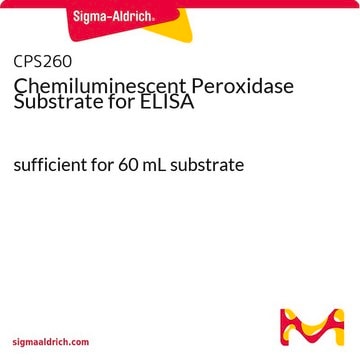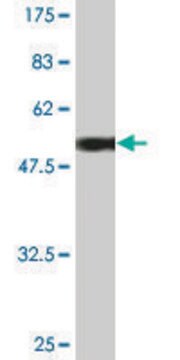11582950001
Roche
BM Chemiluminescence ELISA Substrate (POD)
Synonyme(s) :
ELISA substrate
About This Item
Produits recommandés
Forme
solution
Niveau de qualité
Conditionnement
pkg of 250 mL (for 2500 wells or 1000 tubes)
Fabricant/nom de marque
Roche
Conditions de stockage
(Keep container tightly closed in a dry and well-ventilated place.)
Technique(s)
ELISA: suitable
Couleur
clear colorless
Solubilité
water: miscible
Adéquation
suitable for chemiluminescence
Conditions d'expédition
wet ice
Température de stockage
2-8°C
Catégories apparentées
Description générale
Application
Caractéristiques et avantages
- Improved sensitivity
- Large dynamic range
- Rapid and constant signal
Contents
Substrate Reagent A (buffered solution that contains luminol/4-iodophenol)
Starting Reagent B (buffered solution that contains a stabilized form of H2O2)
Principe
Notes préparatoires
The BM Chemiluminescence ELISA Substrate is supplied as a set of two stable solutions. Depending on the scale of the assay, the appropriate amount of substrate solution has to be prepared 15 minutes before use:
- Add to 100 parts of solution A one part of solution B.
- Stir the mixture for at least 15 minutes at 15 to 25 °C to equilibrate the components.
Storage conditions (working solution): The premixed solution is stable for 1 week, when stored at 2 to 8 °C.
Autres remarques
Code de la classe de stockage
12 - Non Combustible Liquids
Classe de danger pour l'eau (WGK)
WGK 1
Point d'éclair (°F)
does not flash
Point d'éclair (°C)
does not flash
Certificats d'analyse (COA)
Recherchez un Certificats d'analyse (COA) en saisissant le numéro de lot du produit. Les numéros de lot figurent sur l'étiquette du produit après les mots "Lot" ou "Batch".
Déjà en possession de ce produit ?
Retrouvez la documentation relative aux produits que vous avez récemment achetés dans la Bibliothèque de documents.
Les clients ont également consulté
Notre équipe de scientifiques dispose d'une expérience dans tous les secteurs de la recherche, notamment en sciences de la vie, science des matériaux, synthèse chimique, chromatographie, analyse et dans de nombreux autres domaines..
Contacter notre Service technique


![BM Chemiluminescence Western Blotting Substrate (POD) pkg of 1 set (11500708001 [1,000 cm2 membrane]), pkg of 1 set (11500694001 [4,000 cm2 membrane])](/deepweb/assets/sigmaaldrich/product/images/352/091/ef743cea-ccd8-44f1-8f3b-dec5a1e4f5d1/640/ef743cea-ccd8-44f1-8f3b-dec5a1e4f5d1.jpg)




